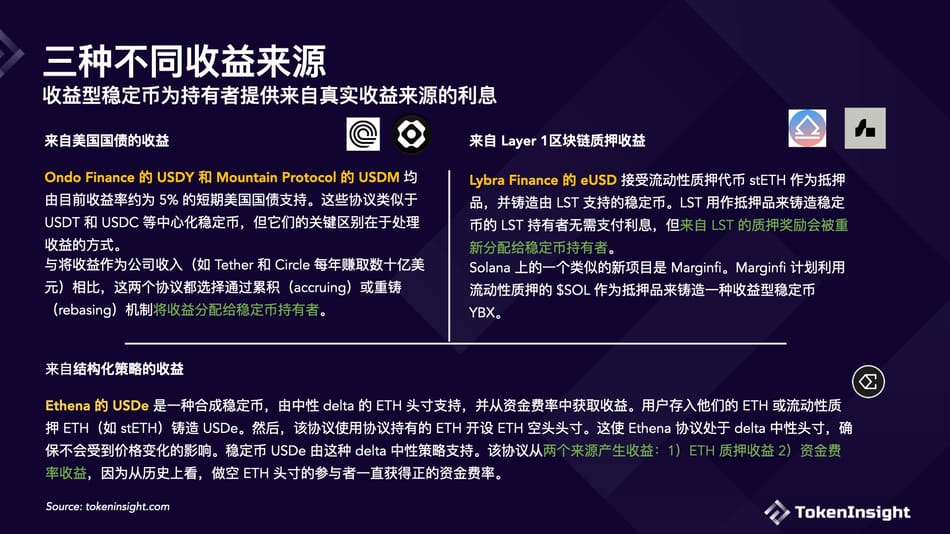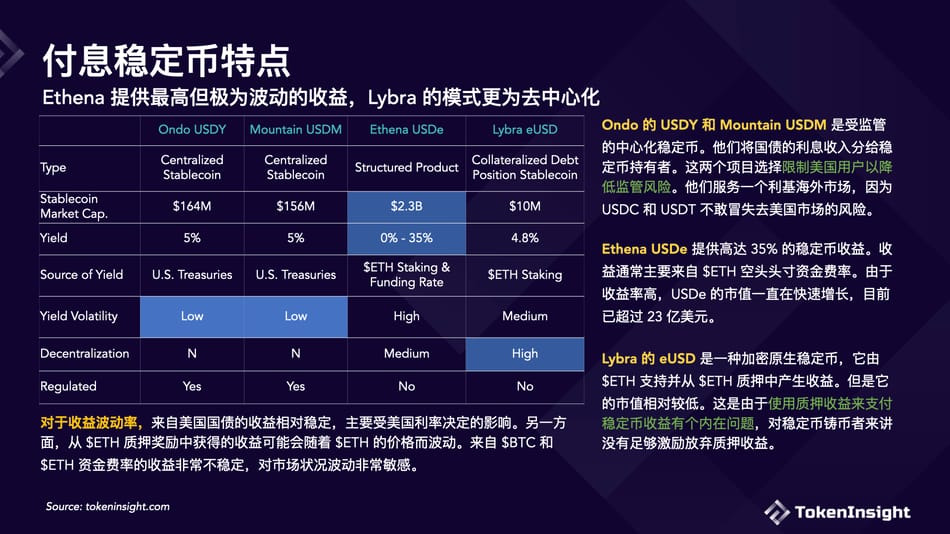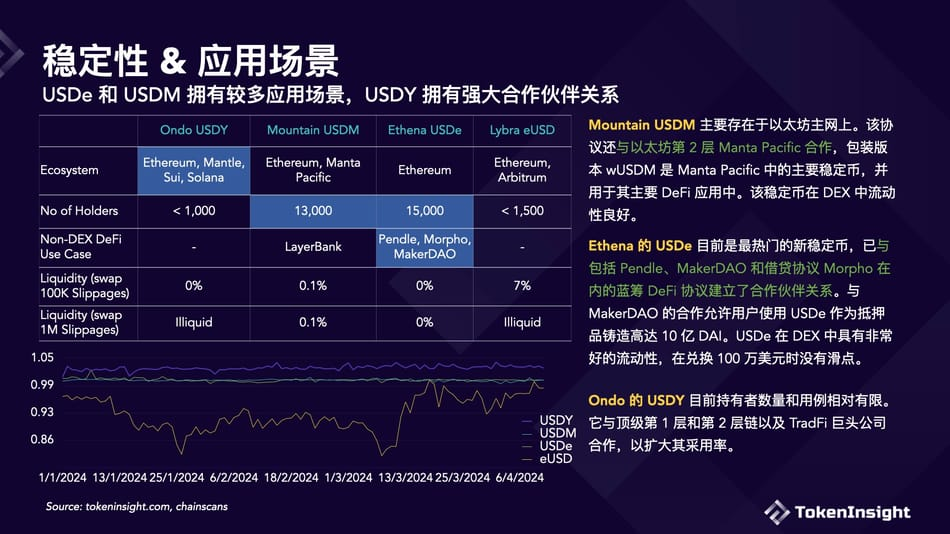Author: 0xEdwardyw
- A new type of interest-bearing stablecoin generates income from three different sources: real-world assets, Layer 1 token staking, and perpetual contract funding rates.
- Ethena offers the highest yield, but also the greatest volatility, while the Ondo and Mountain protocols restrict the use by US users to reduce regulatory risks in order to distribute interest income.
- Lybra's model reallocates the staking income of $ETH to stablecoin holders, making it the most decentralized model, but facing incentive issues.
- In terms of the number of holders and DeFi use cases, Ethena's USDe and Mountain's USDM are leading in stablecoin adoption.
Part One: Diverse Sources of Income

Unlike the previous crypto bull market cycle, algorithmic stablecoins at that time relied on subsidies or native token inflation to provide very high but unsustainable yields, ultimately leading to the collapse of projects such as Terra/Luna's UST. The current cycle of interest-bearing stablecoin innovation provides income from reasonable sources.
The new wave of interest-bearing stablecoins mainly relies on three sources of income:
Income from US Treasury Bonds
Centralized stablecoins are backed by USD deposits and short-term US Treasury securities, which are considered the safest assets in traditional financial markets. Currently, the two largest stablecoins, USDT and USDC, generate billions of dollars in interest income annually from the US Treasury bonds they hold, but do not return these interest earnings to stablecoin holders.
In contrast, new entrants in the centralized stablecoin market aim to challenge the dominance of USDT and USDC by returning the interest income earned from the supporting assets to stablecoin holders. USDY from Ondo and USDM from Mountain Protocol are two typical examples, both providing approximately 5% yield to stablecoin holders.
Income from Layer 1 Blockchain Staking
The second source of income comes from staking native tokens on Layer 1 blockchains. Lybra's eUSD on Ethereum and the upcoming Marginfi on Solana allow users to use liquidity staked tokens (LST) such as stETH and jitoSOL as collateral to mint stablecoins. These are typical collateralized debt position (CDP) stablecoins, with a mechanism similar to MakerDAO's DAI.
Unlike traditional CDP stablecoins, when minters use LST as collateral to borrow stablecoins, they do not incur any borrowing costs or interest on stablecoin loans. The borrowing costs and interest on stablecoin loans are paid from the income generated by the staked LST. In other words, minters redistribute the staking income earned from LST to stablecoin holders.
Income from Structured Strategies
Ethena's USDe is a synthetic stablecoin backed by neutral delta BTC and ETH positions, and earns income from funding rates. Users can deposit their ETH or stake liquidity ETH (such as stETH) to mint USDe issued by the protocol. The protocol then opens a short ETH position on centralized exchanges against the ETH held by the protocol. This puts the Ethena protocol in a delta-neutral position, ensuring it is not affected by price changes. The protocol collaborates with major derivative exchanges including Binance, OKX, and Derbit.
The protocol uses off-chain MPC secure custody accounts to leverage the liquidity of centralized exchanges. This means the protocol is not subject to custody risks associated with centralized exchanges, as all protocol assets are held by regulated institutional-grade digital asset custodians.
The stablecoin USDe is supported by a delta-neutral strategy. The protocol generates income from two sources: 1) ETH staking income and 2) funding rate income. Historically, participants taking short ETH positions have consistently received positive funding rates. In the current bull market, most market participants are long on ETH, making the funding rates for short positions significant.
Part Two: Characteristics of Interest-Bearing Stablecoins

Ethena's USDe Depends on Positive Funding Rates
Ethena's USDe offers up to 30% astonishing yield from positive funding rates in the perpetual futures market. In the perpetual futures market, the funding rate mechanism periodically adjusts the costs between long and short positions. When the demand for long positions exceeds that of short positions, the funding rate is positive, and the funding rate is paid from long futures buyers to short futures buyers. During the crypto bull market, positive funding rates can be very high, allowing Ethena's short positions to earn substantial funding rate income.
According to Ethena, even in bear markets, positive funding rates have historically existed. For example, the funding rate was 18% in 2021, 0.6% in 2022, and 7% in 2023. This means that even in bear market conditions, Ethena can provide higher stablecoin yields, as the yields of major stablecoins were less than 1% during the 2022/2023 crypto bear market. However, past performance does not guarantee future results, and yields are highly sensitive to market conditions. During market pullbacks, with reduced demand for long positions, the income generated from positive funding rates may fluctuate dramatically. Due to the recent market correction, the USDe yield has dropped from 35% to 15%.
Although negative funding rates may occur when the demand for long positions is lower than that of short positions, negative funding rates are not persistent and often revert to a positive mean. When the overall income from ETH staking and funding rates is negative, the protocol has a reserve fund to intervene, ensuring users do not incur negative yields for holding USDe.
Ethena's USDe is supported by a structured trading strategy for $ETH. Although $ETH is a native crypto asset, the trading and hedging strategies are conducted on centralized exchanges and involve regulated crypto custodians. Therefore, USDe is not a decentralized stablecoin.
Lybra's eUSD Requires Incentives for Stablecoin Minters
Lybra's eUSD is minted using over-collateralized liquidity staked $ETH, and the stablecoin's yield comes from $ETH staking income. This approach utilizes native crypto assets and executes on-chain, making it a decentralized stablecoin. The staking income of minters is redistributed to stablecoin holders. While this provides sustainable real income for stablecoin holders, it lacks sufficient incentives to attract stETH holders to mint stablecoins and forgo staking income. Therefore, the protocol has to rely on the issuance of its native token $LBR to subsidize stablecoin minters.
Additionally, while a 5% yield on an interest-bearing stablecoin may be attractive during a bear market, it may not be as attractive during a bull market, as more mature stablecoins can achieve yields of over 10% through DeFi lending.
USDY and USDM Restrict Usage by US Users
Ondo Finance and Mountain Protocol's interest-bearing centralized stablecoins target a niche market that is not fully met by USDC and USDT. Due to regulatory uncertainty in the US, both USDC and USDT do not distribute earned interest income to stablecoin holders. They are concerned that paying stablecoin interest may lead to classification as securities, or they may violate laws by providing interest without obtaining a banking license. USDY and USDM choose to only serve non-US users, restricting the use of their stablecoins by US citizens.
Part Three: Use Cases and Stability

A good stablecoin should have a wide range of use cases in DeFi, deep liquidity in trading, and a large number of holders. Although these emerging interest-bearing stablecoins are unlikely to challenge the market dominance of USDT and USDC in the foreseeable future, they have all adopted different strategies to expand their use cases.
Mountain's USDM and Ethena's USDe show quite good adoption rates in terms of the number of holders and DeFi use cases.
Most of the USDM exists on the Ethereum mainnet, followed by Manta Pacific, with smaller balances on Base, Arbitrum, and Optimism. The Mountain Protocol has partnered with the Ethereum Layer 2 Manta Pacific, and USDM is the primary stablecoin in the Manta Pacific ecosystem and is used in DeFi. USDM can be used as collateral on the largest lending protocol, LayerBank, on Manta Pacific.
Ethena, currently the hottest new stablecoin project, has established partnerships with major DeFi protocols in the Ethereum ecosystem. Collaboration with MakerDAO and Morpho allows users to use USDe as collateral to mint up to 1 billion DAI.
Ondo Finance's USDY is still in the early stages of adoption. The protocol has established partnerships with traditional finance giant BlackRock, as well as leading Layer 1 and Layer 2 chains such as Solana, Mantle Network, and Sui. These partnerships have the potential to significantly increase its adoption. Ondo Finance is currently the hottest project in the real-world assets (RWA) narrative, with a very high fully diluted valuation (FDV). It is important to note that currently, both products, the USDY stablecoin and OUSG on-chain US Treasury bonds, have very limited numbers of holders, with less than 1000 holders for USDY and less than 100 holders for OUSG.
Stability
The trading price of Mountain's USDM and Ethena's USDe is very close to the anchored 1 US dollar, while Ondo's USDY is an interest-bearing token, with a trading price higher than 1 US dollar. Ondo is currently working on launching a rebasing version of USDY so that it can be used as a regular US dollar stablecoin.
Lybra's eUSD has been trading below 1 US dollar for a long time. eUSD is fully collateralized by staked ETH, with a minimum collateralization ratio of 150%. The protocol is secure and has sufficient collateral support. The deviation from the peg can be attributed to a design choice of the protocol mechanism. For over-collateralized stablecoins like eUSD, if the trading price of the stablecoin falls below 1 US dollar, arbitrageurs can purchase the stablecoin at a discount in the open market and then fully redeem the underlying collateral, making a profit. This arbitrage behavior pushes the stablecoin price back up to 1 US dollar. Interestingly, for Lybra Finance, stablecoin minters can choose whether to allow arbitrageurs to redeem their positions. Many users choose not to activate the redemption option, which prevents arbitrage execution.
Liquidity on DEX
We measure the liquidity of stablecoins by the slippage generated when swapping 100K and 1M into USDT in the DEX Aggregator LlamaSwap. When exchanging 1 million tokens, USDe has the best liquidity with no slippage. It is worth noting that despite the smaller market value of USDM, its liquidity is quite good.
免责声明:本文章仅代表作者个人观点,不代表本平台的立场和观点。本文章仅供信息分享,不构成对任何人的任何投资建议。用户与作者之间的任何争议,与本平台无关。如网页中刊载的文章或图片涉及侵权,请提供相关的权利证明和身份证明发送邮件到support@aicoin.com,本平台相关工作人员将会进行核查。




